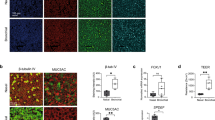Abstract
Mouse nasal airways are often used for the assessment of both reporter and cystic fibrosis transmembrane conductance regulator (CFTR) gene transfer to respiratory epithelia. However, the mouse nasal cavity is lined by both olfactory (OE) and respiratory epithelium (RE). Previous gene transfer studies have suggested that OE may be more efficiently transduced by adenoviral vectors than RE. However, to provide data pertinent to CFTR gene transfer in humans, measurements of CFTR function in mice by transepithelial potential difference (TPD) should be directed towards respiratory rather than olfactory epithelium. We report a new technique to mark the position of the TPD sensing cannula tip in the mouse nasal cavity that permitted us to correlate TPD measurements with epithelial cell type. Using this technique, we found TPD values did not discriminate between respiratory and olfactory epithelia. We next assessed relationships between anatomic regions accessed by the TPD cannula and epithelial type. The frequently used insertion depth of approximately 5 mm from the nose tip predominantly recorded the TPD from anterior dorsal olfactory epithelium. Measurement of the TPD of respiratory epithelium in our study was maximized by insertion of the TPD cannula probe to 2.5 mm depth. Because TPD measurements are not sensitive to epithelial type, adequate control of position and TPD catheter insertion depth are required to ensure accurate estimation of CFTR gene transfer into the target RE in the mouse nasal cavity.
This is a preview of subscription content, access via your institution
Access options
Subscribe to this journal
Receive 12 print issues and online access
$259.00 per year
only $21.58 per issue
Buy this article
- Purchase on Springer Link
- Instant access to full article PDF
Prices may be subject to local taxes which are calculated during checkout



Similar content being viewed by others
References
Grubb BR, Boucher RC . Pathophysiology of gene-targeted mouse models for cystic fibrosis Physiol Rev 1999 79: (1 Suppl.) S193–214
Boucher RC . Status of gene therapy for cystic fibrosis lung disease J Clin Invest 1999 103: 441–445
Mery S et al. Nasal diagrams: a tool for recording the distribution of nasal lesions in rats and mice Toxicol Pathol 1994 22: 353–372
Jiang C et al. Increased contact time improves adenovirus-mediated CFTR gene transfer to nasal epithelium of CF mice Hum Gene Ther 1997 8: 671–680
Parsons DW, Grubb BR, Johnson LG, Boucher RC . Enhanced in vivo airway gene transfer via transient modification of host barrier properties with a surface-active agent Hum Gene Ther 1998 9: 2661–2672
Knowles MR, Paradiso AM, Boucher RC . In vivo nasal potential difference: techniques and protocols for assessing efficacy of gene transfer in cystic fibrosis Hum Gene Ther 1995 6: 445–455
Pickles JR, Barker PM, Hong Y, Boucher RC . Efficient adenovirus-mediated gene transfer to basal but not columnar cells of cartilaginous airway epithelia Hum Gene Ther 1996 7: 921–931
Rochelle LG et al. ENaC mRNA expression suggests an absorptive capacity for mouse distal lung Am J Physiol Lung, Cell Mol Physiol 2000 279: L14–L24
Zeiher BG et al. A mouse model for the delta F508 allele of cystic fibrosis J Clin Invest 1995 96: (4) 2051–2064
Wilschanski MA et al. In vivo measurements of ion transport in long-living CF mice Biochem Biophys Res Commun 1996 219: 753–759
Ramjeesingh M et al. Assessment of the efficacy of in vivo CFTR protein replacement therapy in CF mice Hum Gene Ther 1998 9: 521–528
Grubb BR et al. Inefficient gene transfer by adenovirus vector to cystic fibrosis airway epithelia of mice and humans Nature 1994 371: 802–806
Zabner J, Zeiher BG, Friedman E, Welsh MJ . Adenovirus-mediated gene transfer to ciliated airway epithelia requires prolonged incubation time J Virol 1996 70: 6994–7003
Steagall WK, Elmer HL, Brady KG, Kelley TJ . Cystic fibrosis transmembrane conductance regulator-dependent regulation of epithelial inducible nitric oxide synthase expression Am J Respir Cell Mol Biol 2000 22: 45–50
Delaney SJ et al. Cystic fibrosis mice carrying the missense mutation G551D replicate human genotype-phenotype correlations EMBO J 1996 15: 955–963
Smith SN et al. Bioelectric characteristics of exon 10 insertional cystic fibrosis mouse: comparison with humans Am J Physiol 1995 268: C297–307
Ghosal S, Taylor CJ, McGaw J . Modification of nasal membrane potential difference with inhaled amiloride and loperamide in the cystic fibrosis (CF) mouse Thorax 1996 51: 1229–1232
Ghosal S et al. Sodium channel blockers and uridine triphosphate: effects on nasal potential difference in cystic fibrosis mice Eur Respir J 2000 15: 146–150
Patterson MM, Kesner RP (eds) . Electrical Stimulation Research Techniques Academic Press: New York 1981 p 159
Acknowledgements
T Martella assisted in technique development and data analysis. We thank Prof DI Cook, University of Sydney, for access to CF mice destined for culling. Funding was provided by USA CF Foundation, and by the Women's and Children's Hospital Research Foundation.
Author information
Authors and Affiliations
Rights and permissions
About this article
Cite this article
Parsons, D., Hopkins, P., Bourne, A. et al. Airway gene transfer in mouse nasal-airways: importance of identification of epithelial type for assessment of gene transfer. Gene Ther 7, 1810–1815 (2000). https://doi.org/10.1038/sj.gt.3301317
Received:
Accepted:
Published:
Issue Date:
DOI: https://doi.org/10.1038/sj.gt.3301317
Keywords
This article is cited by
-
An innate contribution of human nicotinic receptor polymorphisms to COPD-like lesions
Nature Communications (2021)
-
Activation of Transgene-specific T Cells Following Lentivirus-mediated Gene Delivery to Mouse Lung
Molecular Therapy (2010)
-
Transduction Efficiencies of Novel AAV Vectors in Mouse Airway Epithelium In Vivo and Human Ciliated Airway Epithelium In Vitro
Molecular Therapy (2009)
-
Expression of CFTR from a ciliated cell-specific promoter is ineffective at correcting nasal potential difference in CF mice
Gene Therapy (2007)
-
Using magnetic forces to enhance non-viral gene transfer to airway epithelium in vivo
Gene Therapy (2006)



